Serving the Bottom of the Pyramid
Jane Chen, MBA ’08, discusses the vision behind Embrace, a joint social enterprise promoting child and maternal health across the globe.
August 28, 2014
For a d.School course called “Design for Extreme Affordability,” Jane Chen and three of her classmates developed a low-cost baby incubator tailored to the needs of the developing world. That incubator—a reusable heating pouch—became the Embrace Infant Warmer, and ultimately launched Embrace and Embrace Innovations, a joint social enterprise promoting child and maternal health across the globe.

The Embrace Infant Warmer won the support of influencers in the field, who recognized that this innovative technology could transform the lives of the most vulnerable populations. With the seal of approval from key opinion leaders, Chen and her colleagues turned their groundbreaking design into the standard of care. Today, the Embrace Infant Warmer has been distributed to almost 3,500 sites around the world, and has helped saved the lives of more than 50,000 infants.
In a Social Innovation Conversation with Jonathan Chang, Sloan ’13, Chen discussed the vision behind Embrace, and how a class project evolved into a multi-faceted social enterprise. As she explained, it took more than a new product to make a lasting improvement in infant health. The newness of their technology presented a problem almost as tough to solve as that d.School assignment: how to drive adoption of a device no one had ever seen before.
“Innovation happens not just with regards to a product,” Chen said. “There are many ways to think about innovation.” For Embrace, she explained, innovation was the fundamental principle behind distributing, marketing, and delivering the warmer to the mothers and infants who needed it the most.
Build Your Credibility Before Distributing Your Product
The expected means of distributing the product might have been to deliver the infant warmer directly to its target customer—in this case, the bottom of the pyramid market. But “it’s often hard to reach the most bottom of the pyramid customers,” Chen said. “So you might want to start a couple of steps above that.”
Even if the ultimate goal of an organization is to reach the most impoverished, Chen recommends that social entrepreneurs hone their product at more stable levels of society. “I think it is better to find your solution and experiment in an environment where things are not as difficult as when you’re really reaching that truly bottom of the pyramid category,” she said.
Not starting with the bottom of the pyramid doesn’t mean that your product won’t reach those who need it. “I think there are more shades of grey within what we conceive to be the bottom of the pyramid,” she explained, “and all of these people are in different degrees of need.” But by initially delivering your product to those with more resources, entrepreneurs can build credibility, improve their design, and increase their chances of reaching the poorest populations on the largest scale possible.
Sell Your Product to the People Your Customers Trust
Initially, when Chen and her colleagues introduced their warmer in India, they found that the people who needed it the most didn’t necessarily want it. An important lesson from Embrace’s early days, Chen said, “is that need and demand are very different things.” Turning need into demand, she explained, required profound behavior change on the part of mothers and caregivers, who had to be educated on how to use the warmers, and convinced of its benefits.
Achieving behavior change proved difficult, Chen recalled, as “a startup with no credibility in a foreign country.” So Embrace reached out to key opinion leaders in the country who had the power to drive adoption of the warmer at all levels of society. Introducing the warmer to these leaders gave Embrace a better platform for educating potential customers about the lifesaving impact of the device.
Reach the Public by Way of the Private Sector
Embrace found its early champions in the private sector. “Private adopters are much more willing to take a risk on something new,” she explained, as opposed to the government, which Chen found can be hampered by bureaucracy and other limitations. “I think it makes more sense to have a multi-pronged approach that starts with the private sector and then expands into the public sector,” she said.
Working with private adopters enabled Embrace to test and refine their product in a limited market. That phase of development proved critical, and put Embrace in a much better position to partner with government. “Based on what we’ve been able to do in the private sector, the Indian government is now starting to place larger and larger orders for the product,” Chen said.
Make Your Nonprofit Profitable
Government buy-in is one way Embrace can reach the bottom-of-the-pyramid—but it’s not the only way. As the Chief Business Officer for Embrace Innovations, Chen integrates nonprofit and for-profit strategies to ensure their products can continue to serve all segments of society. As Chen explained, “the for-profit reaches those who can afford to pay,” and revenue from these sales allows Embrace to donate the warmer to the “poorest of the poor.”
This organizational structure developed to suit Embrace’s needs, and, most importantly, to suit the needs of its target customer. “I think that in order to scale massively, you do need to be profitable,” she said. “And I think that actually goes hand in hand with making social impact, because the greater you can scale, the more impact you’re going to make.”
For Chen and her colleagues, designing the Embrace Infant Warmer was the first step toward solving one of the most intractable problems of global health. But truly making an impact on their target customer required them to bring the same level of creativity to product distribution and delivery. In the end, that proved to be the most critical step in accomplishing their goal of penetrating the bottom of the pyramid market.
As advocates for infant and maternal heath, the founders of Embrace are committed to bringing cutting-edge technology to mothers and infants in the developing world. To create sustainable change in the midst of scarcity and overwhelming need, they’ve enlisted the help of their own advocates, leaders and opinion makers who are in the best position to create demand for their product.
“How do you drive adoption?” Chen asked. “Getting the buy-in of the key opinion leaders, finding your early champions, and over time having it become a standard of care.”
For media inquiries, visit the Newsroom.
Explore More

Gender, Generations, and Tech Give a Richer Picture of Latino/a Entrepreneurs

Short Takes: Where Science Meets Culture



